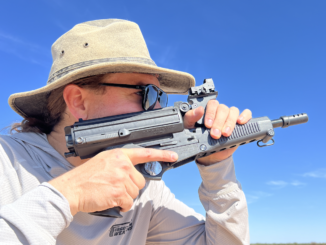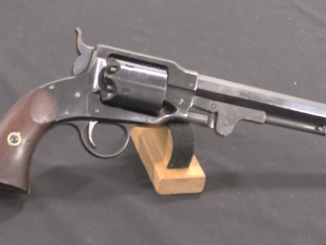The modularity and clever design of the Stemple Takedown Gun is perhaps best illustrated by the STG-M1A and STG-1928 (these are the same gun with either a horizontal or vertical front grip). In the early 2000s a bunch of Thompson parts kits came into the US, WW2 vintage lend-lease guns sent to Russia. They were M1 and M1A1 models, and had intact barrels but torch-cut receivers. BRP, who makes the Stemple, realized that the sear-to-magwell dimensions on the Thompson were almost identical to the Suomi and Stemple – and that he could make a version of the STG that was a nearly perfect clone of the M1 Thompson.
The registered Stemple receiver slides into a square Thompson lookalike housing, and original Thompson grips, stocks, and hand guards are used. It is chambered for .45ACP, using original Thompson stick magazines (naturally). The result isn a submachine gun that almost perfectly duplicates the handling of a true Thompson, without the historical value that makes the Thompson so expensive and keeps many owners from wanting to actually take their Thompsons out to the range.
Note that the example in this video is an early example, and models made today are able to take both stick and drum magazines. Also, due to the deign of the disconnector in the original Thompson FCG, the semiauto setting is not functional in the Stemple version – it’s only full automatic.




Does it weigh as much as the Thompson ?
I don’t know which will run out first- the supply of stemple tubes or parts kits, but Mr Poling’s creativity seems limitless.
“(…)early 2000s a bunch of Thompson parts kits came into the US, WW2 vintage lend-lease guns sent to Russia.(…)”
Oh, so Lend Lease Act was obeyed (lease=you will give it back), just with few decades delay 🙂
Interestingly present example lacks muzzle device, whilst one of 11.43 mm Thompson submachinegun examined in Soviet Union did have one, see 1st photo from top
http://www.tankarchives.ca/2017/09/lend-lease-impressions-submachineguns.html
Soviet testers were not impressed with that weapon. Additionally quality of delivered ammunition left much to be desired.
The photo at the link is labeled “M1928” and has a Cutts compensator muzzle device. The Cutts compensator was one of several features dropped when the US adopted the M1 and M1A versions of the Thompson.
I bought a Thompson “returned from Russia” kit in the mid-2000s. It had a fixed stock and simple (L-shaped piece of metal) rear sight, but a fluted barrel, Cutts compensator, receiver with top-mounted charging handle, and cut for drum magazines. I suspect the guns (and ammo) placed in Lend-Lease vehicles was sort-of “whatever old stuff is around the warehouse.”
Photo of Thompson SMG totting Soviet Naval Infantry, see 1st from top
https://che-ratnik.livejournal.com/402658.html
does show sub-machine guns with drum magazines and Cutts.
Leads to a question now, did Soviet union after 1945. payed US in some way for lend-lease goods ?
Technically yes. A few small payments in 1970s and the bulk between 1990 and 2006.
However it was a zero-percent loan, so the Soviets has acknowledged the debt of 700m 1845 dollars and then repayed 700m of 1972-2006 dollars (well, Russian Federation payed after 1991).
I suspect raw resources (chrome, manganese, even wood) USSR sent during the war were more important than post-war payments even if their monetary value was less.
*700m 1945 dollars, of course.
Thanks for the info and reply. I thought they were maybe silently, behind public cold war animosities, paying for the stuff in 50s-60s etc. to honour the 2nd w. war obligations, but this was not very gentlemans behaviour. Just compare it to what Germany needed to pay, of course, “vae victis”…
Lend Lease could also involve some ‘swapping’ like bases for equipment as we did with Britain. I believe in some cases the swap became permanent. The Blish Device in the m-1928 did not seem to like very cold weather, straight blow back M-1/M-1A reportedly functioned better.
The parts kit did indeed include a Blish lock …
If these came back torch-cut, they were sold to a private company in the US and were not returned to the US military.
There is some problem with these “re-export” SMGs.
There was no re-export.
Officially, the USSR refused to pay for ALL small arms. Because it was declared either “lost in battle” or “unnecessary and subject to return.”
At the same time, no one was taking all this stuff back to the United States. Everything was put under press and into scrap metal on the other side of the ocean.
Therefore, ABSOLUTELY ALL “re-export from Russia” smallarms are stolen.
I know this for sure, since my grandfather served in the air defense of Moscow in 1946-47 and he was the head of the radio components warehouse.
So, he had a separate warehouse, which was never visited with checks.
And in this warehouse lay American radio stations and other “electronic” rubbish, which was quietly taken out and used to provide communication at all important exercises and other events.
Probably because Soviet radio stations were complete crap.
And the American ones provided high-quality communication and did not break.
Of course, under “ABSOLUTELY ALL” there is a weapon supplied under the Lend-Lease program.
There were also other get-and-pay deliveries, the exact volume and content of which are unknown.
Effective, reliable radios may be taken for granted now, but in WWII they were in short supply in many places. One could call them a “forgotten weapon” Germany lacked a source of Mica and thus had problems with making good low value capacitors, although the designs were as good as they could be otherwise. Japan lacked experience in radio design and copied “distress radios” (i.e., portable units for lifeboats) purchased before the war. In the 1920’s and ’30’s there was a radio mania in the US and many companies understood the technology completely and had the manufacturing resources to make them in quantity. That experience and capacity also led to the proximity fuse, which is another “forgotten weapon” that was important in the war.
“…In the 1920’s and ’30’s there was a radio mania in the US…”(С)
This has a direct analogy with machine gun construction.
While everyone could design and manufacture weapons, there were many enthusiasts. From the mass of which, by natural selection, the most successful were distinguished.
Now, when it has become something between an honorary privilege and a venereal disease, only the “chosen ones” are engaged in this, appointed to the position NOT on the basis of professional suitability, but “with optimal personal data and appropriate recommendations”…
we have what we have.
Namely dull shit, suitable only for tactical masturbators.
And an understanding user will rather take an UZI, M45 or M3A1 (If he can find them, of course. 😉 ).
Or even Thompson or MP40 instead of all this newfangled junk.
This “non-Thompson” is a great example of the engineering and thinking outside the box combination that is so typical of a free enterprise environment!